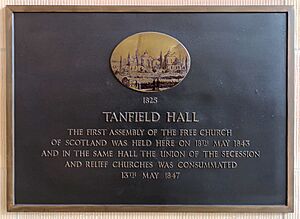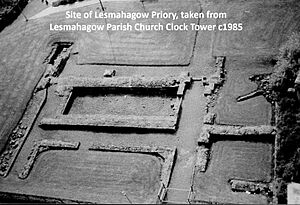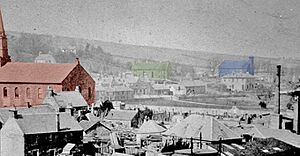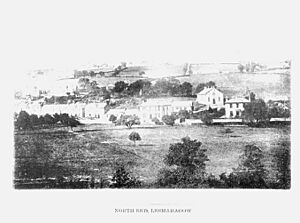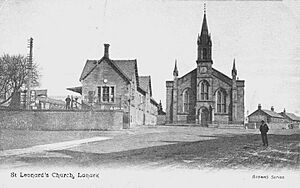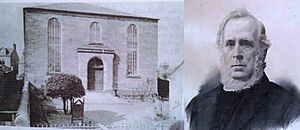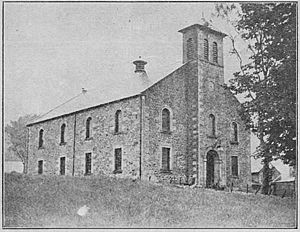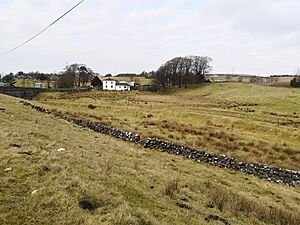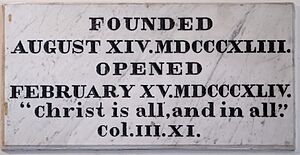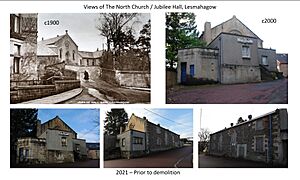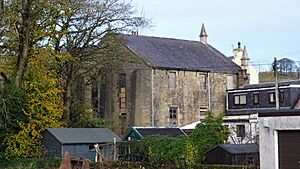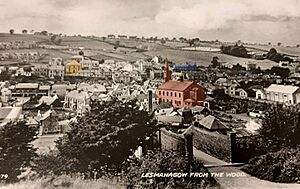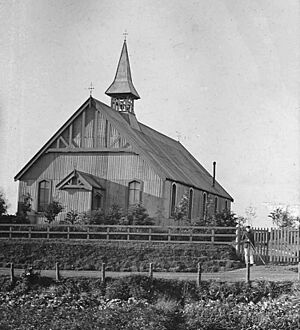Abbeygreen Church facts for kids
Quick facts for kids Abbeygreen Church |
|
|---|---|
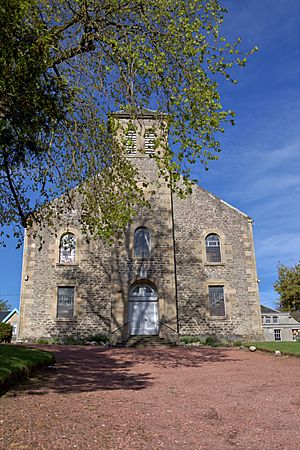 |
|
| 55°38′26″N 3°53′13″W / 55.64057°N 3.886878°W | |
| Denomination | Free Church of Scotland |
| Churchmanship | Christian, Protestant, Presbyterian, Reformed |
| Website | Abbeygreen, Scottish Reformed Conference |
| Administration | |
| Parish | Abbeygreen Parish |
| Presbytery | Glasgow & Argyll |
Abbeygreen Church is a Christian church located in the small town of Lesmahagow, Lanarkshire, Scotland. It is part of the Free Church of Scotland. This church believes the Holy Bible is the most important guide for life and what they believe. They also follow the Westminster Confession of Faith, which helps explain Christian teachings.
Abbeygreen Church is a "Presbyterian" church, which means it is led by a group of elders and ministers, not just one person. It is part of the Free Church of Scotland's Glasgow Presbytery. The church also helps support missionary groups and the Scottish Reformed Conference.
The church started during a big event in Scottish history called the Disruption of 1843. Its first stone was laid in August 1843, and the church building opened on February 15, 1844. The church, its minister's house (manse), and grounds are located next to Glebe Park on Abbeygreen. The people who formed Abbeygreen Church left the Parish Church of Lesmahagow in 1843.
Contents
- What is the Disruption of 1843?
- Christianity in Lesmahagow Before the Disruption
- Churches in Lesmahagow During the Disruption
- The Disruption from a Local Viewpoint
- Events After the Disruption
- Building Up Abbeygreen Free Church
- Ministers of Abbeygreen Free Church Until 1900
- Changes and Mergers Over Time
- Returning to the Free Church of Scotland
- Images for kids
What is the Disruption of 1843?
The story of Abbeygreen Church really begins with the Disruption of 1843. This was when many ministers and church members left the Church of Scotland. It happened at the Church of Scotland's main meeting (the General Assembly) in 1843.
The reason for this split was that the Church of Scotland allowed the government to interfere in church matters, like choosing ministers. The people who left believed that only Jesus Christ should be the head of the church, not the government.
At that meeting, 121 ministers and 73 elders, led by Dr. David Welsh, read a protest and then left. They formed the first General Assembly of the Free Church of Scotland in Edinburgh on May 18, 1843. Thomas Chalmers was their first leader.
In total, 474 ministers left the Church of Scotland to create the Free Church of Scotland in 1843. Over the years, some parts of the Free Church joined with other churches. In 1900, most of the Free Church joined with the United Presbyterian Church to form the United Free Church of Scotland. The remaining part continued as the Free Church of Scotland we know today.
Later, in 1929, most of the United Free Church of Scotland joined back with the Church of Scotland. Abbeygreen Church followed these changes for many years. However, in September 2019, the Abbeygreen Church congregation decided to leave the Church of Scotland. This process finished on March 26, 2020, and Abbeygreen Church rejoined the Free Church on March 31, 2020.
Christianity in Lesmahagow Before the Disruption
Christianity has been in the Lesmahagow area since at least the 1100s. A church dedicated to Saint Machutus (also known as Saint Malo) was built then. The first leader of the Lesmahagow Priory was Osbert, who later became the Abbot of Kelso in 1180.
The priory was dedicated to Saint Machutus after King David I of Scotland gave the "Church and lands of Lesmahagow" in 1144 to a group of monks from the Tironensian Order. These monks had established Kelso Abbey in Kelso. You can still see the remains of Lesmahagow Priory (or "Abbey") next to Lesmahagow Old Parish Church today. The main road through Lesmahagow, Abbeygreen, and Abbeygreen Church both get their names from this old "Abbey."
After the Scottish Reformation in 1560, the church in the area became part of the Church of Scotland. Lesmahagow was affected by the religious and political troubles of the 1600s, especially the relationship between the church and the government. Many monuments in the area remember the Covenanters, who were people who fought for the church's freedom during that time.
- Covenanter Memorials: There are memorials to people like William Lawrie, James Gavin, John Brown, and David Steel, who suffered for their beliefs. Auchengilloch Moor was a place where Covenanters held secret outdoor church meetings called "conventicles."
By the early 1800s, people in Lesmahagow still remembered the Covenanter period and the "Killing Times." They were very aware of the problems caused by the government's interference in the church, especially the 1711 Patronage Act. This act allowed landowners to choose ministers for churches, even if the church members didn't want them.
Because of this, several other Presbyterian churches formed in the area, like the Secession Church (from 1733) and the Relief Church (from 1761). These churches also split from the Church of Scotland over issues like church leadership and patronage. This shows that people in Lesmahagow cared deeply about having the freedom to choose their own ministers.
Churches in Lesmahagow During the Disruption
Lesmahagow Parish was one of only two parishes in the Church of Scotland's Lanark area directly involved in the Disruption of 1843. Other Presbyterian churches in the area also played a part in the history of Abbeygreen Church.
There are other Christian churches in Lesmahagow today, like the Hope Hall, which is an Open Brethren church. Abbeygreen Church and Hope Hall have a friendly relationship and support each other in their Christian work in Lesmahagow.
Lesmahagow Parish Church of Scotland
At the time of the Disruption, the main minister of Lesmahagow Parish Church was Rev. Dr. Andrew Borland Parker. He arrived in 1839. Lesmahagow Parish Church had two ministers, a first and a second. When Dr. Parker arrived, the second minister was Rev. Dr. John Wilson, who passed away in 1842. Rev. Thomas Burns took his place.
Dr. Parker arrived just before events in 1839 and 1842 made the issue of patronage very clear to the people of Lesmahagow.
The North Church, Lesmahagow
The North Church in Lesmahagow was a "Secession" church. It started getting its own minister in 1814 and formed its own church leadership in 1816. Their first minister, Rev. William Logan, started in 1820.
This branch of the Secession church rejoined the Church of Scotland on September 11, 1839. This created a third minister position in the Lesmahagow Parish of the Church of Scotland.
The Reformed Presbyterian Church, Ponfeigh
Near Douglas Water, there was a Reformed Presbyterian Church led by Rev. John Milwain. This church became important to Abbeygreen's history right after the Disruption of 1843.
St Leonard's Church, Lanark
St. Leonard's Church in Lanark was built in 1841. Its minister, Thomas Stark, became a Free Church minister in 1843. Because of a disagreement over the building, the Free Church congregation bought another church on Hope Street in Lanark.
The Relief Church or "Cordiner" Church
The Cordiner Church started as the Lesmahagow Relief Church in 1837. It was named after its second minister, Rev. Robert Cordiner, who served there from 1846 to 1897. The Cordiner Church was located where Cordiner Court is now.
The Relief Church was part of a movement that started in 1761. For many years, these smaller churches struggled to find enough ministers and buildings. They often held outdoor meetings, like the Covenanters did.
The need for a Relief Church in Lesmahagow was noticed in 1836, and preachers were sent. The congregation formed on November 7, 1837, and their church, with 724 seats, opened in August 1838.
Its first minister, Mr. Alexander Lindsay, left in 1845 and later joined the Free Church in 1848. Rev. Robert Cordiner took over in 1846, and the church grew under his leadership. In 1847, the Relief Church joined with another group to form the United Presbyterian Church.
The Disruption from a Local Viewpoint
1839: When Patronage Was Refused
Rev. Dr. Andrew Boreland Parker became the minister of Lesmahagow Parish Church in April 1839. In September 1839, the North Church joined the Church of Scotland, becoming the third minister position in Lesmahagow.
However, the Duke of Hamilton, who was the local landowner, refused to allow the North Church's minister, Rev. William Logan, to continue in his role. This was a clear act against the minister and the church members. Despite this, the North Church congregation continued to worship in their building with Rev. William Logan as their minister. This building later became known as the Jubilee Hall.
1842: A Second Refusal of Patronage
When the second minister's position at Lesmahagow Parish Church became empty in 1842, Rev. William Logan was chosen by the congregation to fill it. He received 293 votes, while Rev. Thomas Burns received 205.
But the Duke of Hamilton chose Rev. Thomas Burns instead, going against the wishes of the congregation. Rev. Burns became the second minister on September 29, 1842.
1842: The Congregation's Will Rejected
This situation in Lesmahagow was not unique. Across Scotland, landowners often ignored the wishes of church members who wanted to choose their own ministers. The Church of Scotland tried to give congregations more power in 1833, but it didn't really work.
With all these events happening in Lesmahagow in 1839 and 1842, Dr. Parker called a meeting of the Lesmahagow Parish Church congregation on December 28, 1842. Many members agreed to support ministers who were faithful to the Bible and believed the church should be independent from government control.
After the Church of Scotland's General Assembly on May 28, 1843, Dr. Parker preached his last sermon in the Parish Church. He said he could no longer be part of a church that allowed the government to control its spiritual matters. Dr. Parker, five of the seven elders, and 800 church members left the Church of Scotland to form the Free Church of Scotland.
1843 and 1844: Abbeygreen Free Church is Built
The new congregation had no building or land, and they faced strong opposition from some people in the village and local landowners.
Dr. Parker, the minister, found a house to rent about 3.5 miles southeast of Lesmahagow. A surgeon named Mr. Robert Frame, who was a member of the Parish Church, allowed the congregation to meet for worship in a field called "the Muttonhole." This was about 3.6 miles southeast of Lesmahagow.
Since it was a good summer, the congregation worshipped outdoors. People from nearby towns like Douglas, Rigside, Douglas Water, and Coalburn came to listen. Outdoor preaching continued there even after the Abbeygreen Church building was finished.
Mr. James Brown of Auchlochan arranged to get a piece of land next to the Glebe fields from the Duke of Hamilton. The first stone of the new church was laid in August 1843. On February 15, 1844, Abbeygreen Free Church opened. It was built without debt and without help from the Free Church's central fund. The building was designed to hold 960 people.
Events After the Disruption
The First Free Church of Scotland Meeting in Lanark
When the Disruption happened in 1843, Rev. William Logan and the North Church joined the Free Church of Scotland. Soon after, Rev. William Logan was asked to become the minister of Sanquhar Free Church.
In June 1843, at the first meeting of the Free Church Presbytery of Lanark, two important decisions were made. First, they decided to combine the North Church and the congregation that came out of the Church of Scotland. This was to avoid having two Free Churches in Lesmahagow when many other parts of Scotland had none. Second, they decided that the North Church building was too small for the new Free Church members in Lesmahagow.
The North Church's Response
After hearing the Presbytery's decisions, the North Church congregation decided to invite Rev. John Milwain from the nearby Reformed Presbyterian Church at Ponfeigh to preach. The North Church then joined the Reformed Presbyterian Church on March 4, 1844. Some members chose to join Lesmahagow Free Church instead.
The North Church shared its minister with Ponfeigh for a while. However, due to money problems, the North Church congregation closed in 1869. The church building was later changed into the village hall and, from 1887, became the Jubilee Hall. The building was taken down in August 2021 to make way for a new house.
Rev. William Logan, Minister of Sanquhar Free Church
Although the minister of Sanquhar Church of Scotland did not leave in 1843, many of his church members did. They formed a Free Church congregation and built a new church in Sanquhar in 1844. This is the congregation that asked Rev. William Logan to be their minister.
Rev. Logan accepted the call and served as minister of Sanquhar Free Church until he passed away in 1863. It is thought that Rev. Logan's decision to move to Sanquhar might have helped the new Free Church congregation in Lesmahagow get land for their buildings from the Duke of Hamilton. He may have seen it as God's plan to help the new church in Lesmahagow.
Building Up Abbeygreen Free Church
After the Abbeygreen Church building was finished, the congregation immediately started Sunday Schools and regular schools with libraries. They also built the church manse (minister's house) in 1844. A Free Church School was built on Peasehill, Lesmahagow, in 1851.
The church also started several "mission stations" in the local area. These led to new Free Church congregations being formed. For example, the church in the nearby village of Coalburn started as a mission station in 1893 and became an independent Free Church congregation in 1895. Free Church congregations were also established in Douglas (church built in 1845) and Rigside/Douglas Water (church built in 1886). These new churches grew partly because of the outdoor preaching that happened in 1843 and afterward.
Ministers of Abbeygreen Free Church Until 1900
Dr. Parker continued as minister of Abbeygreen until 1854, when he moved to a Free Church in Glasgow. On May 16, 1856, Rev. James Laing became the new minister. Mr. Laing served Abbeygreen until February 25, 1872, when he moved to another church in Glasgow. His successor, Rev. James Arthur Gray, became minister on November 22, 1872.
Changes and Mergers Over Time
1900: Abbeygreen Joins the United Free Church of Scotland
In 1900, most of the Free Church joined with the United Presbyterian Church to form the United Free Church of Scotland. Abbeygreen Church became part of this new church. Mr. Gray continued as minister until he retired in 1927. Then, on October 27, 1927, Rev. John Walker became the minister of Abbeygreen.
1929: Abbeygreen Joins the Church of Scotland
Early in Rev. Walker's time as minister, in 1929, the United Free Church rejoined the Church of Scotland. The Church of Scotland had changed its rules to honor the principles of the Disruption, by getting rid of the patronage system in 1874 and through other laws in 1921 and 1925. So, the congregation that became Abbeygreen found itself back within the Church of Scotland as Lesmahagow-Abbeygreen on October 2, 1929.
This merger also brought the Cordiner Church into the Church of Scotland. This meant there were three Church of Scotland churches in Lesmahagow village! Rev. Walker's ministry ended in May 1939, and Rev. T.F. Neill became the new minister on January 25, 1940.
1940: Union with the Cordiner Church
The Cordiner Church had joined the United Presbyterian Church in 1847. Then, in 1900, it joined the United Free Church of Scotland along with Abbeygreen. So, Abbeygreen and the Cordiner Church were in the same church group, but they were still separate congregations. In 1929, both churches followed the majority of the United Free Church of Scotland into the Church of Scotland. They became Lesmahagow-Abbeygreen and Lesmahagow-Cordiner Church, alongside Lesmahagow Old Parish Church.
In 1940, the minister of the Cordiner Church, Mr. Morton, became very ill. Abbeygreen Church and the Cordiner Church had always supported each other. So, the Cordiner Church members were invited to worship with Abbeygreen. In June 1941, the two churches discussed joining together, and in July 1941, they officially united. This created Lesmahagow-Abbeygreen, Church of Scotland. This new church had a special way of organizing things, separating the church's money and property from its spiritual matters. The first meeting of the new combined church leadership happened on July 7, 1941.
When Abbeygreen rejoined the Free Church of Scotland in 2020, two members of the congregation had actually been part of the Cordiner Church Sunday School many years ago. They were Mr. Jim Brown and Mrs. Nancy Lang, who had served Abbeygreen Church for a long time.
1941 to 2020: Ministry within the Church of Scotland
After uniting with the Cordiner Church, Rev. T.F. Neill served Abbeygreen until 1953. On April 6, 1954, Rev. Dr. Robert B.W. Walker became the minister. Dr. Walker served until he had to retire due to illness in October 1981. After a period without a minister, Rev. David S. Carmichael became the new minister on September 2, 1982. He served the church until his retirement on January 29, 2023.
Returning to the Free Church of Scotland
On March 26, 2020, the congregation of Abbeygreen Church, along with its elders and minister, left the Church of Scotland. They formed Abbeygreen New Church, meeting online once on March 29. The church had worked with the Church of Scotland to secure its land and buildings, completing the transfer on the morning of March 26, just before Scotland's legal system closed down due to the COVID-19 pandemic.
On March 31, 2020, the minister was accepted into the Free Church of Scotland, and the Abbeygreen congregation was happily welcomed back into the Free Church of Scotland, where it had started in 1843. The online meeting on March 29, 2020, was necessary because the Scottish Government closed public gatherings from March 26 due to the virus. The church now operates under the Free Church of Scotland's rules, with a Kirk Session (spiritual leaders) and a Finance Committee. The church's property and money are managed by a charity called Abbeygreen Ministries Trust.
Images for kids


